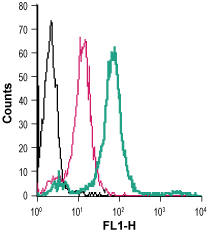Overview
Application key:
Species reactivity key:
Specifications
- Peptide CT(S)SFDRIRGRPYTT, corresponding to amino acid residues 166-180 of human GPR84 (Accession Q9NQS5). 2nd extracellular loop.
Applications
- Mouse BV-2 microglia cells, human THP-1 monocytic leukemia cells (2.5-5 µg).
 Cell surface detection of GPR84 in live intact mouse BV-2 microglia cells:___ Cells.
Cell surface detection of GPR84 in live intact mouse BV-2 microglia cells:___ Cells.
___ Cells + rabbit IgG isotype control-FITC.
___ Cells + Anti-GPR84 (extracellular)-FITC Antibody (#AGR-052-F), (5 µg). Cell surface detection of GPR84 in live intact human THP-1 monocytic leukemia cells:___ Cells.
Cell surface detection of GPR84 in live intact human THP-1 monocytic leukemia cells:___ Cells.
___ Cells + rabbit IgG isotype control-FITC.
___ Cells + Anti-GPR84 (extracellular)-FITC Antibody (#AGR-052-F), (2.5 µg).
Scientific Background
GPR84 is an orphan G-protein coupled receptor (GPCR) activated by micromolar concentrations of medium-chain fatty acids (MCFAs). MCFAs that activate GPR84 are usually with carbon chain lengths of 9-14, which couples primarily to a pertussis toxin (PTX)-sensitive Gi/o pathway. The most potent agonists of GPR84 includes decanoic acid, undecanoic acid and lauric acid. GPR84 demonstrates an important role in inflammation, immunity, and cancer1-3.
GPR84 is predominantly expressed in immune system-related tissues and cells, such as bone marrow, spleen, lung, lymph nodes and brain microglia, T-cells, macrophages and glial cells. Its expression is also detected in adipocytes.
Studies have shown that GPR84 activation in murine macrophage-like cell line results in high levels of LPS-stimulated IL-12 p40 production. In addition, GPR84 knockout mice display increased Th2 cytokine production1-3.
